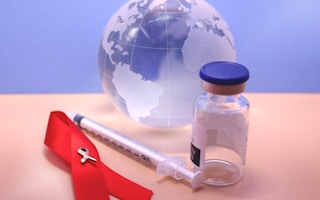People living with HIV are living longer nowadays, thanks to several factors, including the successful implementation of public health interventions and campaigns, advances in science and technology, and strong global leadership and advocacy.
With the development of antiretroviral therapy (ART), HIV testing uptake improved globally, as it became apparent that only people diagnosed with the disease through testing would receive the medication. In Asia and the Pacific, ART coverage among people living with HIV increased from 19 per cent in 2010 to 41 per cent in 2015, an increase of 24 per cent from 2010, and by the end of 2022, about 76 per cent of people living with HIV globally had access to ART.
With over 20 approved ART medications and the rapid global scale-up of ART coverage, the mortality rate of people living with HIV is decreasing and the age at HIV diagnosis is increasing. Consequently, there is a growing proportion of people living with HIV who are over 50 years old.
Alongside the establishment of the Joint United Nations Program on HIV/AIDS (UNAIDS) in 1996, the global community launched the Millennium Development Goals (MDGS) in 2000, and the subsequent Sustainable Development Goals (SDGs) in 2015, with their respective targets of reversing HIV by 2015 (MDG 6) and eliminating AIDS by 2030 (SDG 3).
Despite these efforts and scientific advances, by the end of 2022, about 39 million people were living with HIV, 1.3 million had acquired new HIV infections, and about 630,000 had died from AIDS-related causes globally.
The achievements of the last four decades in HIV prevention, treatment and care face a critical threat of reversal due to the stigma associated with HIV.
Defined as prejudice, negative attitudes and abuse directed at people living with HIV, HIV-related stigma significantly impedes the health outcomes, well-being and life experiences of people living with HIV. It also discourages people living with HIV from seeking treatment and staying in care.
Characterised by its multidimensional nature, HIV-related stigma manifests in the form of discrimination, familial and societal shunning, the erosion of rights, violence and psychological trauma. It drives discrimination in several sectors of society, including healthcare, education, the workplace, the justice system, and within social settings. According to the World Health Organization, one of the main reasons people are reluctant to get tested for HIV is the fear of stigma and discrimination.
HIV-related stigma is also worsened by one’s sex, race, sexual orientation, gender identity, socioeconomic status or national origin. According to the Centers for Disease Control and Prevention (CDC), key populations in certain countries such as men who have sex with men, sex workers, transgender people and people who inject drugs, have trouble accessing HIV services at public health facilities due to the fear of violence and arrest.
Ageism — negative attitudes, stereotypes and behaviours directed towards older adults based solely on their perceived age — is a particularly challenging aspect of HIV prevention, treatment and care. Older people are more likely than younger people to receive a delayed diagnosis for HIV. This is because older people may mistake HIV symptoms for signs of normal ageing and thus, not discuss symptoms with their doctors. Late HIV diagnosis causes older people to receive a delayed start to HIV treatment, poorer prognosis and shorter survival rates. According to a CDC report, 34 per cent of people aged 55 and older in the US in 2021 had late-stage infection when diagnosed with HIV.
A 2021 study on HIV, ageism and stigma documented social isolation, lack of social support and discrimination among older adults living with HIV. The stigma experienced negatively affects the quality of life, self-image and behaviour of the elderly, and often prevents them from disclosing their HIV status or seeking HIV treatment and care.
The elimination of HIV-related stigma is key to achieving the global aspiration of leaving no one behind and meeting the SDG target of ending AIDS by 2030. It is also at the heart of the 2021–2026 Global AIDS Strategy and its 10–10–10 targets on societal enablers.
Thus, by adopting the 2021 Political Declaration on HIV/AIDS, UN Member States echoed the Global AIDS Strategy and committed to implement urgent and transformative action to end social, economic, racial and gender inequalities, restrictive and discriminatory laws, policies and practices, stigma, and multiple intersecting forms of discrimination, including those based on a person’s HIV status, and human rights violations that perpetuate the AIDS epidemic.
To address HIV-related stigma, countries are beginning to tackle intersectional stigma simultaneously as it is key to ensuring health equity, as HIV-related stigma is not only associated with whether a person is living with the disease or not, but also with their gender identity, sexual orientation, place of treatment and the communities in which they live.
Additionally, the CDC, through the US President’s Emergency Plan for AIDS Relief (PEPFAR), is providing ‘safe space’ clinics for key populations. While this approach is working in the short-term, sustainable solutions, such as expanding training for nurses and doctors on HIV-related stigma and discrimination, and the provision of culturally competent care for key populations in various countries are important. It must be noted that although the White House and Congress through a bipartisan vote reauthorised PEPFAR through the PEPFAR Extension Act of 2018 through 2023, budget cuts could irreversibly threaten the momentum gained over the past 16 years.
Furthermore, the widespread adoption of the people living with HIV Stigma Index 2.0 has created opportunities for countries and communities to obtain evidence‐based data on the intersectionality of stigma and to effectively implement stigma mitigation interventions.
The global community recognises the impact of HIV-related stigma on HIV prevention. To effectively address the issue, ongoing efforts to eliminate HIV-related stigma should continue, with a focus on additional culturally innovative, meaningful, comprehensive and sustainable responses adopted by the global community
Dr Elizabeth Armstrong-Mensah is a clinical associate professor at the Georgia State University School of Public Health.
Originally published under Creative Commons by 360info™.








